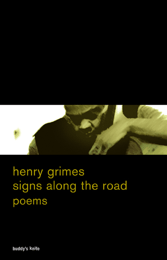Home » Jazz Articles » Book Review » Signs Along The Road
Signs Along The Road
 Signs Along The Road
Signs Along The Road Henry Grimes
Soft cover; 128 pages
ISBN: 978-3-00-020142-4
Buddy's Knife
2007
Bassist Henry Grimes was one of the leading lights on the free jazz scene in the 1960s, playing with many of the music's most famous names, including pianist Cecil Taylor, multi-instrumentalist Don Cherry, reed player Pharoah Sanders and saxophonist Albert Ayler. Financial struggle forced him away from jazz and in 1968 he stopped playing. But fortunately, several years later, he met his future wife and manager, Margaret Davis, who back in 2002, started a search for a bass so Grimes could play music again. The quest was successful, resulting in Grimes' triumphant return to the jazz scene.
The story of Grimes' renaissance has become almost mythological, but what is lesser known is that while he took an extended break from music, he never abandoned artistic expression. Throughout the many years of musical abstinence, he wrote constantly, filling his diaries with poems. Thanks to the publisher and editor, Renate Da Rin, a generous selection of Grimes' poetry is presented in book form by Buddy's Knife.
Signs Along the Road spans several decades, and includes poetry written as recently as 2005, but the bulk of the work comes from the 1980s. In other words, the poetry presented here is not the spontaneous jottings of an amateur, but excerpts from an artist's lifelong existential search, an artist whose medium has included not only music, but also words. In fact, in Grimes' work there is a close correspondence between music and poetry: both are languages, which try to say what it is not possible to say in everyday language. Grimes is known as a musician who doesn't talk a lot, but in his poetry he speaks with a profound, wise voice.
A leitmotif in several poems is the use of time, which is explored on several levels throughout the collection. It emerges as the metaphor of nature, the river of time, and as the passing of people, places and history, the different shapes of memory, but most of all it reveals itself as the investigation of form. Perhaps the most striking definition of art as the sculpting of time is presented in "monk music" whose first extensive stanza deserves to be quoted verbatim:
"Music functions in a pattern. Patterns. Patterns function in a whiz; the worse for patternistry which is not there. The gems of few lines. Then—music functions whole, patterns into system patterns. Thus do patterns become history and music—forms. Yes, do pages of phrases write motion, still things—that move, that have lines in mystery, because the best music then forms benign of misery."
Here, the correspondence between music, writing and time is clear and so is the relation between the creation of the moment and history: "patterns become history." The notion of time also shows itself in the use of enjambment and dash, that little word of punctuation so brilliantly explored by Emily Dickinson. With his use of poetic form, Grimes extends and expands time—the words are in motion, just like music being played in the moment. The musical effect of the words is also underlined by rhythm, rhyme, alliteration and assonance as in the last lines: "because the best music then forms benign of misery."
Time moves through three stages in the poems; the time of the individual subject, the time of history and the time of art. While Grimes is interested in all aspects of time, he is mostly concerned with the aspect of artistic time. What is remarkable about artistic time is that it unfolds itself through a subject to transcend subjectivity: "Yes, do pages of phrases write." It is the pages that write not the artist.
The experience passed on in Grimes' words is that humans exist on three time-levels: individually, historically and transcendentally. It is the achievement of the poet Grimes that he is able to show the coexistence of these levels, bringing the reader closer to the true essence of being.
Tags
PREVIOUS / NEXT
Support All About Jazz
 All About Jazz has been a pillar of jazz since 1995, championing it as an art form and, more importantly, supporting the musicians who make it. Our enduring commitment has made "AAJ" one of the most culturally important websites of its kind, read by hundreds of thousands of fans, musicians and industry figures every month.
All About Jazz has been a pillar of jazz since 1995, championing it as an art form and, more importantly, supporting the musicians who make it. Our enduring commitment has made "AAJ" one of the most culturally important websites of its kind, read by hundreds of thousands of fans, musicians and industry figures every month.





















